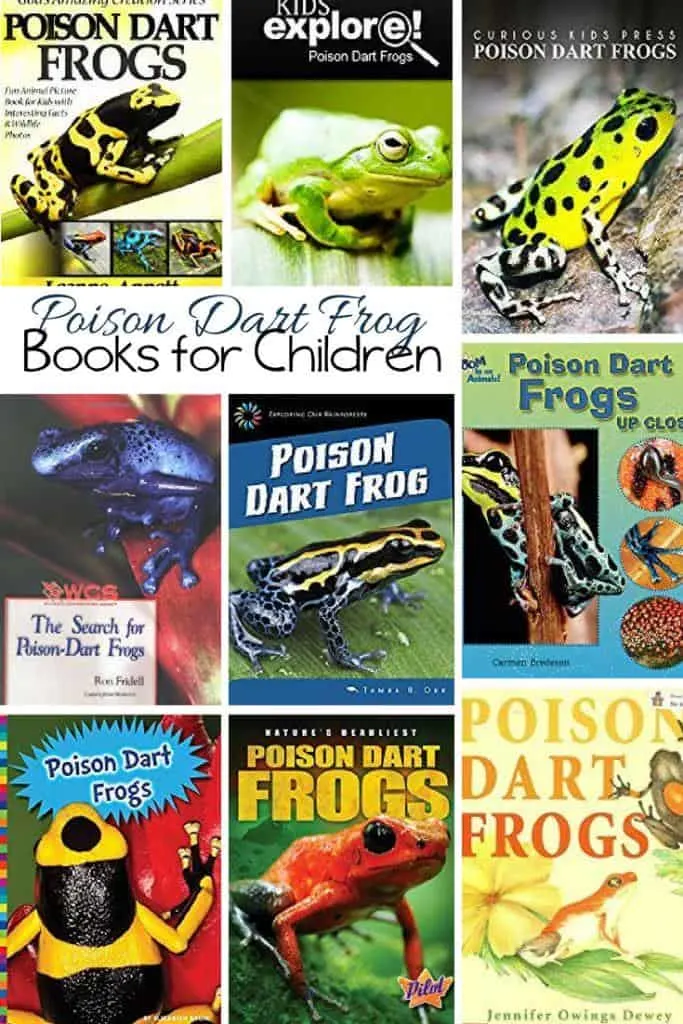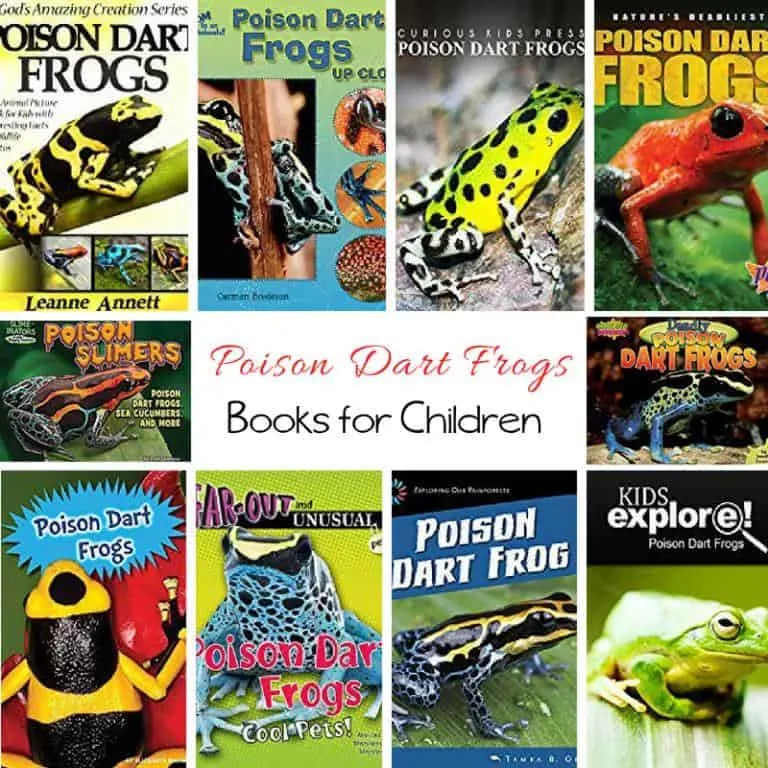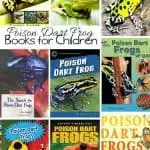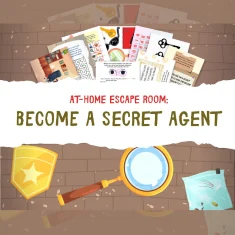These Poison Dart Frog Books for Kids are sure to please and fascinate your children as they learn all about this awesome Rainforest Animal.
These books contain so much information about the Poison Dart Frog as well as stories about people from the Rain Forest.
The following Poison Dart Frog-themed books for kids cover all aspects of the home-school education coin – from picture books to workbooks; from learning to read up to chapter books!
Check out our other great book recommendations for kids as well!

The kids will love learning all about the various types of animals and amphibians and reptiles that live in and among the rain forest.
What is the poison dart frogs favorite foods?
They love crickets and fruit flies so if you see any of those around a poison dark frog, you better believe that they’re going to get eaten!
Is the poison dart frog endangered?
Yes, they were added to the endangered list in 1973.
Rainforest Unit Study Resources:
Rainforest Animals Facts Sheets
Rainforest Animals Preschool Learning Kit
How can I make books fun for kids?
As a parent or educator, inspiring children to love reading can be a challenge. While some kids gravitate towards books naturally, others show less interest. However, making books fun can be an effective way to engage kids and encourage their love for reading.
One way to achieve this is by introducing a variety of genres and formats such as graphic novels, picture books, and interactive books that offer creative experiences.
Additionally, promoting reading as a family or classroom activity can foster a positive environment for children to engage with books.
Using imaginative ways to incorporate the story, like acting out characters or creating a themed sensory experience can also add excitement and encourage kids to read more.
By making books an enjoyable experience, children can develop a lifelong love of reading.
How do I encourage kids to read?
Encouraging kids to read is essential to their growth, development, and future success. As a parent or caregiver, there are numerous ways to inspire and motivate children to read.
Firstly, create a reading-friendly environment by providing easy access to books and reading materials. Set aside a specific time of day for reading and make it a daily routine.
Also, choose books that align with their interests and abilities. Additionally, lead by example and show them that reading is enjoyable. Take turns reading to each other and ask questions about the story to make it interactive.
Lastly, reward them for their efforts and progress to keep them motivated and excited about reading.
With these approaches, children are sure to develop a love for reading that will benefit them throughout their lives.
Why do kids love to read?
Children often have a natural affinity for reading, and there are many reasons for this. One factor is that reading provides kids with entertainment, allowing them to escape into exciting or imaginative worlds.
Many children also enjoy the sense of accomplishment that comes with reading and mastering new skills. Additionally, reading books, magazines, or other materials can help children develop social and emotional skills as they engage with characters and their experiences.
By reading, children can also expand their vocabulary, increase their comprehension abilities, and improve their critical thinking.
Overall, reading appeals to many children because it is a fun and engaging way to learn and explore new ideas.
How often should kids read?
Reading is an essential skill that benefits children in numerous ways. It enhances their cognitive development, improves their language and vocabulary, and fosters their creativity.
As parents, it is important to encourage and cultivate a love for reading in children. But how often should kids read? The answer depends on several factors, including their age, reading level, and personal interests.
However, as a general rule of thumb, children should read for at least 20-30 minutes a day. This routine can be established by incorporating reading sessions before bedtime, during car rides, or even after school.
By making reading a regular part of their day, kids can reap the countless rewards that come with being lifelong readers.
Why is it fun to learn about frogs?
There’s something undeniably exciting about exploring the world of frogs. With over 7,000 species worldwide, each with its own unique attributes and quirks, there’s a wealth of information and fascination to be had.
For starters, there’s the sheer diversity of their physical appearance, from the striking colors of poison dart frogs to the camouflaged patterns of tree frogs. But it’s not just their looks that make frogs so intriguing.
Their habitats, adaptations, and behaviors are equally captivating, whether it’s learning about their complex vocalizations or their vital role in the ecosystem.
Plus, frog populations are often used as indicators of environmental health, making the study of these fascinating creatures all the more important.
So why is it fun to learn about frogs? As it turns out, there’s no shortage of reasons.
Poison Dart Frog Books for Kids:
The following Poison Dart Frog books for kids are all available at Amazon. Simply click the book image (aff link) to be taken there.

Poison Dart Frog Books for Kids
These Poison Dart Frog Books for Kids are great for learning.
This is one of the Poison Dart Frog books for kids, in which you will discover exciting facts about the featured animal. Be sure to pay attention, because at the end of the book, you will be tested for your knowledge.
Low on the reading scale but high on the ick factor, these photo-filled Poison Dart Frog books for kidsintroduce emergent readers to some unusual animals while helping them conquer reading on their own.
"How does a poison dart frog release its deadly, toxic mucus when a predator attacks? And which underwater slime producer shoots sticky, poisonous, spaghetti-like threads from its butt to repel its enemies? In this brand-new title, learn the answers to these questions and moreand prepare to get slimed!
Describes a journey into the rain forests of Surinam to see brightly colored poison-dart frogs in their natural habitat, and discusses efforts to preserve them.
Introduces facts about poison dart frogs, including physical features, habitat, life cycle, food, and threats to these rainforest creatures. Photos, captions, and keywords supplement the narrative of this informational text. Questions in the back ask for text-dependent analysis.
This is one of my favorite wildlife photography and facts Poison Dart Frog books for kids intended for early readers! Make sure to pay attention throughout the entire book because you'll be tested for your knowledge at the end.
Bright colors can mean danger! Poison dart frogs may be small, but their bright colors keep others away. Read Poison Dart Frogs to find out why most animals leave these rain forest frogs alone.
Children’s author Leanne Annett presents this fun and informative book with gorgeous color photographs of these unique animals as well as interesting facts on a selection of Poison Dart Frogs.
In this book you will find 15 amazing animal facts accompanied by high quality photos!At the end of this book you will also discover 5 quiz questions for testing your knowledge.This book is perfect for a "read-along" learning experience with your child.
Presents information about the Poison dart frogs of South America, looking at their physical characteristics, how they use their distinctive coloration to warn off predators, what they eat, how they behave, and how they care for their eggs.
If you've ever considered keeping an unusual pet, the FAR-OUT AND UNUSUAL PETS series is for you! Learn the history, the science, and the care needed for keeping fun and exotic pets, such as a poison dart frog. Authors Alvin and Virginia Silverstein, and Laura Silverstein Nunn explain everything you need to keep your pet safe and happy.
A poison dart frog's colorful body warns other animals to stay away. The bright colors reveal that the frog can kill with its powerful venom. In this book, young readers will learn why they should keep their distance from this small, poisonous amphibian.
In richly colored pencil drawings, Jennifer Owings Dewey, who has had a lifetime fascination with frogs, shows different kinds of poison dart frogs in their rain forest environment. Consulting with rain forest experts, she has gathered the most up-to-date information about these amazing frogs in this intriguing book for readers of all ages. Full color .
The Life Cycle of a Poison Dart Frog (Nature's Life Cycles)
This photo-illustrated book for elementary readers describes the venomous poison dart frog. Readers learn how these rainforest frogs use venom to as a protection against predators. Also explains how people have used the poison for hunting and medicines.
Poison dart frogs are cute and tiny. They come in many eye-catching colors. These colors, however, arent meant to make them attractive. The bright colors tell other animals that they shouldnt try to eat them. These vibrant amphibians are covered with a deadly poison that makes predators very sick. Its so strong that some Native American tribes even used it to make poison darts for hunting. Readers will surely enjoy getting up close to these small but deadly poison dart frogs.
Poison Dart Frogs (Really Wild Life of Frogs)
Why are they called poison dart frogs, anyway? Learn the answer to this question and more in this exciting installment in the ZOOM IN ON ANIMALS! series. Colorful, up-close photos of these beautiful, tiny frogs in their native habitats give readers a stunning view of these fascinating creatures.
Offering fascinating insight into life in the rain forest, this book follows a poison dart frog through its day as it sleeps, eats, and moves.
Peter the poison dart frog was taking one of his tadpoles to a place where it can grow. But things were not what they seemed to be. A stick that walks, a leaf that jumps, and bark that flies put Peter and his tadpole at peril.


































